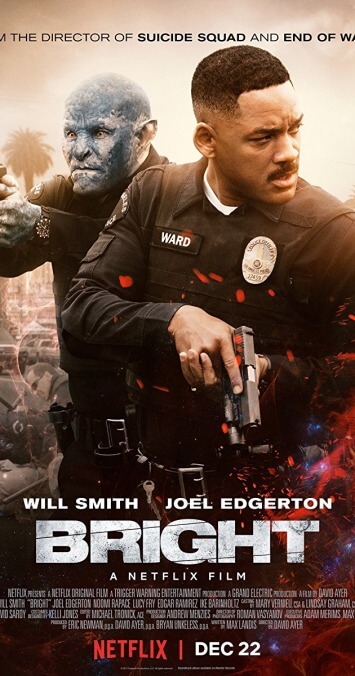Will Smith's Netflix blockbuster Bright is stunning in its audacity—and its stupidity

Finally, high fantasy for the sunglasses-on-the-back-of-the-head set. If nothing else, you have to admire the audacity of the Netflix executives who greenlit Bright: The core conceit of this film—a violent, R-rated cop movie that just so happens to have fantasy creatures in it—is so batshit bonkers that it’s kind of impressive that they made it, let alone spent $90 million on it. Making the whole enterprise even more precarious is the fact that it’s an original script, without the brand recognition that helped mitigate the risk of another unusual genre hybrid released earlier this year, Logan. But let us be clear, reader: Logan, this is not.
Things appear to have gone sideways shortly after the acquisition of Max Landis’ screenplay with the hiring of David Ayer, director of End Of Watch and the technically Oscar-winning Suicide Squad. Bright aims for the grittiness and “one crazy night” structure of the former, but wallows in the chest-thumping goofiness of the latter, not only by smearing some very expensive-looking CGI and makeup effects with a thick layer of grime but in its fixation on cartoonish graffiti, face tattoos, and Latino men calling each other “holmes.” (Supposedly, Ayer’s obsession with Chicano street culture comes from a period where he briefly lived in South Central L.A. as a teenager. It shows.)
Ayer personally did a rewrite on Landis’ initial script for the film, which goes a long way towards explaining the odd mix of blunt boorishness and nerdy snark in the dialogue. (It’s not clear who’s responsible for the colossally stupid line, “Fairy lives don’t matter.”) It’s an film composed almost entirely of locker-room comebacks—witness the line, “this ain’t no small talk, it’s bigass talk”—most of them delivered by Daryl Ward (Will Smith at his most glib), a human beat cop whose feelings towards his family, fellow officers, and especially his orc partner Nick Jakoby (Joel Edgerton) seem to change from scene to scene. Nick, who lives between worlds as the first orc to serve on the Los Angeles Police Department, is the only really stable character in the film. He’s loyal, humble, and honest, which makes you wonder why the LAPD isn’t made up entirely of orcs when the humans are all morally compromised and/or indifferent assholes.
The reason, as is laid out in the beginning of the film, is fantasy racism. Bright takes place in a world where a Lord Of The Rings-type battle between orcs, elves, and humans took place 2,000 years ago, and takes the place of the birth of Christ in the religious and moral canon. Fast-forward to now, when the elves have formed a moneyed upper class who, in Daryl’s words, spend their time “running the world and shopping.” Orcs, meanwhile, are an oppressed underclass whose community is terrorized with impunity by human police officers, while humans, as racially diverse in this world as in ours, enjoy a status somewhere in the middle.
Magic is a real and dangerous presence in this world—there’s even a federal Magic Task Force—and the plot of Bright revolves around Nick and Daryl’s quest to protect a volatile magic wand, and the elfin woman Tikka (Lucy Fry) who wields it. Tikka has defected from a cult led by Leilah (Noomi Rapace), whose wardrobe and skill in wholesale slaughter seem imported from a video game. Leilah and her cronies are on a mission to bring back an ancient “Dark Lord” who will plunge the world into darkness and enslave everyone. Or something like that. It doesn’t really matter. What matters is that there are also individuals, mostly elfin but sometimes human, called “Brights” who can wield magic wands without literally exploding, adding a pinch of fantasy “chosen one” narrative to the over-the-top action.
Bright gestures vaguely at an allegory about police brutality and race, which may have been more impactful in the original script. It’s hard to tell. For his part, Landis has largely disowned the final product, which buries some glimmers of interesting ideas under a thick layer of adolescent tough-guy posturing. (Did we mention the Joe Rogan cameo?) The surfaceness of Bright’s world-building in its pursuit of badassery ironically undermines its impact at every turn, like a would-be powerful scene of Nick pushing through a hallway jammed with hostile fellow officers who laugh at him as he goes by. Institutional racism? Well, yeah. But he’s also got a “kick me” sign on his back.
Perhaps if you were only half-watching Bright in the background while playing on your phone, the chaos of the storytelling wouldn’t matter, because you wouldn’t notice it. You’d chuckle occasionally at a Will Smith one-liner, and look up whenever there was an explosion, watching just long enough to catch the impressive makeup job on Joel Edgerton. “That’s Joel Edgerton?!,” you’d say, then go back to scrolling through your various feeds. If that was Netflix’s goal in making the movie, then they succeeded. The question, then, is why’d they spend so much money on it?